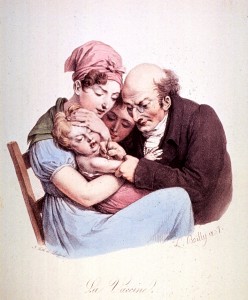Vaccine Week: A Brief History and How Vaccines Work
Surprising Science discusses the history and science of vaccines

In light of President Obama’s declaration of “national emergency” imposed by the outbreak of the H1N1 virus, Surprising Science is setting this week aside to discuss the history and science of vaccines and their importance in battling viruses and diseases, including swine flu.
More than two millennia ago in China or India, someone noticed that people who suffered and recovered from certain diseases never became reinfected. In a leap of logic, the person who noticed the connection tried to prevent the disease by inoculating themselves (or perhaps someone else) with a bit of infected matter.
That idea, now called vaccination, bumbled along through history until 1796. That’s when an English physician named Edward Jenner noticed that milkmaids rarely got smallpox, though they often had blisters from cowpox, which they caught from their cows. Jenner thought that the cowpox might prevent the women from getting smallpox. To test his idea, he took some material from the cowpox blister of a milkmaid and inoculated 8-year-old James Phipps. Six weeks later, Jenner injected young Phipps with fluid from a smallpox sore; Phipps didn’t contract smallpox.
Over the next decades, smallpox vaccination spread, and it was a common practice by the end of the 19th century. Around that time, two more vaccines were developed—by Louis Pasteur—against anthrax and rabies. The 20th century would see the development of vaccines for more than a dozen other diseases, including polio, measles and tetanus.
Long after Jenner’s first discovery, biologists would discover how vaccines work to prime our immune systems to fight off infections:
Though the original smallpox vaccine used a related virus, cowpox, most vaccines use a weakened or dead form of whatever disease they’re meant to prevent. Some of these vaccines will also include a substance called an adjuvant that boosts the effectiveness of the vaccine. (Scientists figured out the workings of alum, one type of adjuvant, last year.)
When the vaccine is injected, a person's immune system recognizes it as a foreign substance. Immune cells called macrophages digest most of the foreign material, but they keep a portion to help the immune system remember it. These identifying molecules are called antigens, and macrophages present these antigens to white blood cells called lymphocytes (which come in two types: T cells and B cells) in the lymph nodes. A mild immune response occurs, and even after the vaccine material is destroyed, the immune system is primed for a future attack.
The next time that a microbe with those antigens enters the body, the lymphocytes are ready to quickly recognize the microbe as foreign. When that happens, B cells make antibodies that attack the invading microbe and mark it for destruction by macrophages. If the microbe does enter cells, T cells attack those infected cells and destroy them before the disease can multiply and spread. The microbe is defeated before it can get a foothold in the body, before the person gets sick.
Tomorrow—Vaccine Week, Day 2: Success Stories
/https://tf-cmsv2-smithsonianmag-media.s3.amazonaws.com/accounts/headshot/Sarah-Zielinski-240.jpg)
/https://tf-cmsv2-smithsonianmag-media.s3.amazonaws.com/accounts/headshot/Sarah-Zielinski-240.jpg)